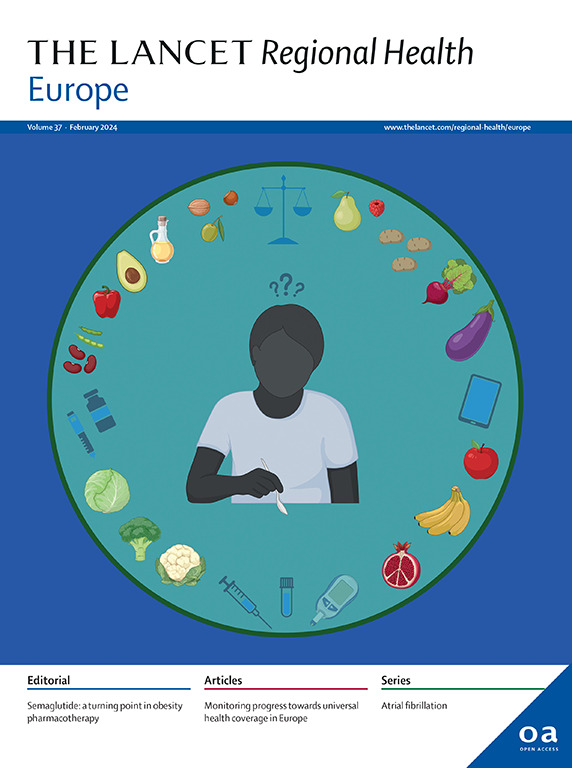英格兰和威尔士(1971-2018)48年来所有癌症综合生存指数的趋势:一项基于人群的登记研究
IF 13
Q1 HEALTH CARE SCIENCES & SERVICES
引用次数: 0
摘要
癌症生存趋势是卫生系统在癌症管理方面取得进展的关键指标。我们的目标是为所有癌症组合提供一个数生存指数的长期趋势,以支持国家癌症政策。方法:我们研究了英格兰和威尔士成年人所有癌症合并后的净生存指数(癌症生存指数)的长期趋势。净生存率包括所有癌症患者,无论癌症是否是其死亡原因。我们使用英格兰国家疾病登记局和威尔士癌症情报和监测部门的匿名个人记录,估计了1971-2018年期间诊断为原发性侵袭性癌症的10,769,854名成年人在诊断后长达10年的净生存率,并随访至2019年。我们检查了癌症生存指数(CSI)在诊断后1年、5年、7年和10年的趋势,使用了整个数据集。我们给出了选定时期的结果:1971-72年、1980-81年、1990-91年、2000-01年、2005-06年、2010-11年和2018年。在1971年至2018年的48年间,英格兰和威尔士的CSI在诊断后10年内都大幅上升。1971-72年诊断的患者,诊断后1年的CSI为46.5%。2018年确诊的患者,10年后该指数为49.8%。自上世纪70年代初以来,女性的CSI一直比男性高10%左右。改善的速度有所放缓:在2000-01至2005-06年间,10年期CSI上升了4.0%。10年后,2010-11年度和2015-16年度之间的增幅仅为1.4%。自2010年以来,英格兰和威尔士所有癌症的CSI长期趋势有所放缓,至少部分原因可能是等待诊断和治疗的时间更长。必须制定一项长期的国家癌症计划,使癌症生存趋势回到世界上最好的水平。资助英国癌症研究。本文章由计算机程序翻译,如有差异,请以英文原文为准。
Trends over 48 years in a one-number index of survival for all cancers combined, England and Wales (1971–2018): a population-based registry study
Background
Trends in cancer survival are a key indicator of progress in the effectiveness of the health system in managing cancer. We aimed to provide long-term trends in a one-number index of survival for all cancers combined, to support national cancer policy.
Methods
We examined long-term trends in a one-number index of net survival (Cancer Survival Index) for all cancers combined in adults in England and Wales. Net survival includes all cancer patients, regardless of whether cancer was the cause of their death. We estimated net survival up to 10 years after diagnosis for 10,769,854 adults diagnosed with a first, primary, invasive cancer during 1971–2018 and followed up to 2019, using anonymised individual records from the National Disease Registration Service for England and the Welsh Cancer Intelligence and Surveillance Unit. We examined trends in the Cancer Survival Index (CSI) at one, five, seven and 10 years after diagnosis, using the entire data set. We present results for selected periods: 1971–72, 1980–81, 1990–91, 2000–01, 2005–06, 2010–11 and 2018.
Findings
During the 48 years 1971–2018, the CSI for England and Wales rose substantially, at all intervals up to 10 years after diagnosis. For patients diagnosed in 1971–72, the CSI was 46.5% at 1 year after diagnosis. For patients diagnosed in 2018, the index is 49.8% at 10 years after diagnosis. The CSI has remained about 10% higher for women than men since the early 1970s. The speed of improvement has slowed down: between 2000–01 and 2005–06, the 10-year CSI rose by 4.0%. Ten years later, the increase between 2010–11 and 2015–16 was only 1.4%.
Interpretation
The slow-down since 2010 of long-term trends in the CSI for all cancers combined in England and Wales is likely to be at least partly explained by longer waits for diagnosis and treatment. A long-term national cancer plan to bring cancer survival trends back towards the best in the world is essential.
Funding
Cancer Research UK.
求助全文
通过发布文献求助,成功后即可免费获取论文全文。
去求助
来源期刊

Lancet Regional Health-Europe
Multiple-
CiteScore
19.90
自引率
1.40%
发文量
260
审稿时长
9 weeks
期刊介绍:
The Lancet Regional Health – Europe, a gold open access journal, is part of The Lancet's global effort to promote healthcare quality and accessibility worldwide. It focuses on advancing clinical practice and health policy in the European region to enhance health outcomes. The journal publishes high-quality original research advocating changes in clinical practice and health policy. It also includes reviews, commentaries, and opinion pieces on regional health topics, such as infection and disease prevention, healthy aging, and reducing health disparities.
 求助内容:
求助内容: 应助结果提醒方式:
应助结果提醒方式:


